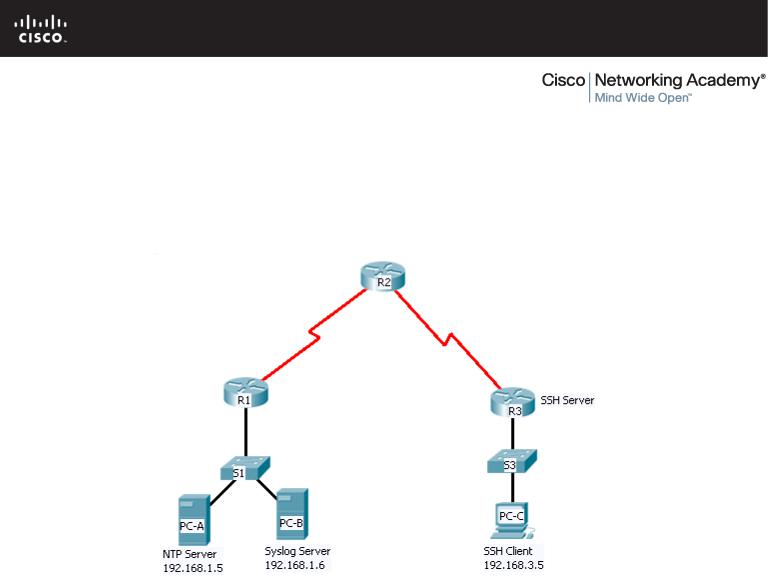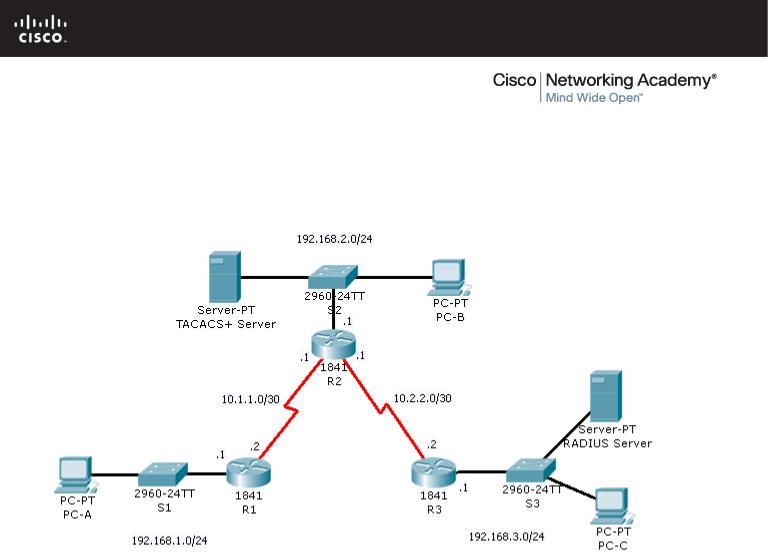
BEZ_2012 / РУКОДСТВА_ДЛЯ_LABWORKS / security_manual_pt4
.pdf
CCNA Security 1.0.1
Instructor Packet Tracer Manual
This document is exclusive property of Cisco Systems, Inc. Permission is granted to print and copy this document for non-commercial distribution and exclusive use by instructors in the CCNA Security course as part of an official Cisco Networking Academy Program.

PT Activity: Configure Cisco Routers for Syslog, NTP, and SSH Operations
Instructor Version
Topology Diagram
Addressing Table
Device |
Interface |
IP Address |
Subnet Mask |
Default Gateway |
Switch Port |
|
|
|
|
|
|
|
|
R1 |
FA0/1 |
192.168.1.1 |
255.255.255.0 |
N/A |
S1 |
FA0/5 |
|
S0/0/0 (DCE) |
10.1.1.1 |
255.255.255.252 |
N/A |
N/A |
|
R2 |
S0/0/0 |
10.1.1.2 |
255.255.255.252 |
N/A |
N/A |
|
|
S0/0/1 (DCE) |
10.2.2.2 |
255.255.255.252 |
N/A |
N/A |
|
R3 |
FA0/1 |
192.168.3.1 |
255.255.255.0 |
N/A |
S3 |
FA0/5 |
|
S0/0/1 |
10.2.2.1 |
255.255.255.252 |
N/A |
N/A |
|
PC-A |
NIC |
192.168.1.5 |
255.255.255.0 |
192.168.1.1 |
S1 |
FA0/6 |
PC-B |
NIC |
192.168.1.6 |
255.255.255.0 |
192.168.1.1 |
S2 |
FA0/18 |
PC-C |
NIC |
192.168.3.5 |
255.255.255.0 |
192.168.3.1 |
S3 |
FA0/6 |
All contents are Copyright © 1992–2010 Cisco Systems, Inc. All rights reserved. This document is Cisco Public Information. |
Page 1 of 5 |

CCNA Security
Learning Objectives
•Configure routers as NTP clients.
•Configure routers to update the hardware clock using NTP.
•Configure routers to log messages to the syslog server.
•Configure routers to timestamp log messages.
•Configure local users.
•Configure VTY lines to accept SSH connections only.
•Configure RSA key pair on SSH server.
•Verify SSH connectivity from PC client and router client.
Introduction
The network topology shows three routers. You will configure NTP and Syslog on all routers. You will configure SSH on R3.
Network Time Protocol (NTP) allows routers on the network to synchronize their time settings with an NTP server. A group of NTP clients that obtain time and date information from a single source have more consistent time settings and Syslog messages generated can be analyzed more easily. This can help when troubleshooting issues with network problems and attacks. When NTP is implemented in the network, it can be set up to synchronize to a private master clock, or to a publicly available NTP server on the Internet.
The NTP Server is the master NTP server in this lab. You will configure the routers to allow the software clock to be synchronized by NTP to the time server. Also, you will configure the routers to periodically update the hardware clock with the time learned from NTP. Otherwise, the hardware clock will tend to gradually lose or gain time (drift) and the software clock and hardware clock may become out of synchronization with each other.
The Syslog Server will provide message logging in this lab. You will configure the routers to identify the remote host (Syslog server) that will receive logging messages.
You will need to configure timestamp service for logging on the routers. Displaying the correct time and date in Syslog messages is vital when using Syslog to monitor a network. If the correct time and date of a message is not known, it can be difficult to determine what network event caused the message.
R2 is an ISP connected to two remote networks: R1 and R3. The local administrator at R3 can perform most router configurations and troubleshooting; however, since R3 is a managed router, the ISP needs access to R3 for occasional troubleshooting or updates. To provide this access in a secure manner, the administrators have agreed to use Secure Shell (SSH).
You use the CLI to configure the router to be managed securely using SSH instead of Telnet. SSH is a network protocol that establishes a secure terminal emulation connection to a router or other networking device. SSH encrypts all information that passes over the network link and provides authentication of the remote computer. SSH is rapidly replacing Telnet as the remote login tool of choice for network professionals.
The servers have been pre-configured for NTP and Syslog services respectively. NTP will not require authentication. The routers have been pre-configured with the following:
•Enable password: ciscoenpa55
•Password for vty lines: ciscovtypa55
•Static routing
All contents are Copyright © 1992–2010 Cisco Systems, Inc. All rights reserved. This document is Cisco Public Information. |
Page 2 of 5 |

CCNA Security
Task 1: Configure routers as NTP Clients.
S tep 1. T es t C onnectivity
•Ping from PC-C to R3.
•Ping from R2 to R3.
•Telnet from PC-C to R3. Exit the Telnet session.
•Telnet from R2 to R3. Exit the Telnet session.
S tep 2. C onfigure R 1, R 2 and R 3 as NT P clients .
R1(config)# ntp server 192.168.1.5
R2(config)# ntp server 192.168.1.5
R3(config)# ntp server 192.168.1.5
Verify client configuration using the command show ntp status.
S tep 3. C onfigure routers to update hardware clock.
Configure R1, R2 and R3 to periodically update the hardware clock with the time learned from NTP.
R1(config)# ntp update-calendar R2(config)# ntp update-calendar R3(config)# ntp update-calendar
Verify that the hardware clock was updated using the command show clock.
S tep 4. C onfigure routers to times tamp log mes s ages .
Configure timestamp service for logging on the routers.
R1(config)# service timestamps log datetime msec
R2(config)# service timestamps log datetime msec
R3(config)# service timestamps log datetime msec
Task 2: Configure routers to log messages to the Syslog Server.
S tep 1. C onfigure the routers to identify the remote hos t (S ys log S erver) that will receive logging mes s ages .
R1(config)# logging host 192.168.1.6 R2(config)# logging host 192.168.1.6 R3(config)# logging host 192.168.1.6
The router console will display a message that logging has started.
S tep 2. Verify logging configuration us ing the command s how logging.
S tep 3. E xamine logs of the S ys log s erver.
From the Config tab of the Syslog server’s dialogue box, select the Syslog services button. Observe the logging messages received from the routers.
Note: Log messages can be generated on the server by executing commands on the router. For example, entering and exiting global configuration mode will generate an informational configuration message.
All contents are Copyright © 1992–2010 Cisco Systems, Inc. All rights reserved. This document is Cisco Public Information. |
Page 3 of 5 |

CCNA Security
Task 3: Configure R3 to support SSH connections.
S tep 1. |
C onfigure a domain name. |
Configure a domain name of ccnasecurity.com on R3. |
|
|
|
|
R3(config)# ip domain-name ccnasecurity.com |
S tep 2. |
C onfigure us ers for login from the S S H client on R 3. |
Create a user ID of SSHadmin with the highest possible privilege level and a secret password of ciscosshpa55.
R3(config)# username SSHadmin privilege 15 secret ciscosshpa55
S tep 3. C onfigure the incoming VT Y lines on R 3.
Use the local user accounts for mandatory login and validation. Accept only SSH connections.
|
|
|
|
|
R3(config)# line |
vty 0 |
4 |
|
|
R3(config-line)# |
login |
|
local |
|
R3(config-line)# |
transport |
input ssh |
||
S tep 4. E ras e exis ting key pairs on R 3.
Any existing RSA key pairs should be erased on the router.
R3(config)#crypto key zeroize rsa
Note: If no keys exist, you might receive this message: % No Signature RSA Keys found in configuration.
S tep 5. G enerate the R S A encryption key pair for R 3.
The router uses the RSA key pair for authentication and encryption of transmitted SSH data. Configure the RSA keys with a modulus of 1024. The default is 512, and the range is from 360 to 2048.
R3(config)# crypto key generate rsa [Enter]
The name for the keys will be: R3.ccnasecurity.com
Choose the size of the key modulus in the range of 360 to 2048 for your General Purpose Keys. Choosing a key modulus greater than 512 may take a few minutes.
How many bits in the modulus [512]:1024
% Generating 1024 bit RSA keys, keys will be non-exportable...[OK]
Note: The command to generate RSA encryption key pairs for R3 in Packet Tracer differs from those used in the lab.
S tep 6. Verify the S S H configuration.
Use the show ip ssh command to see the current settings. Verify that the authentication timeout and retries are at their default values of 120 and 3.
S tep 7. C onfigure S S H timeouts and authentication parameters .
The default SSH timeouts and authentication parameters can be altered to be more restrictive. Set the timeout to 90 seconds, the number of authentication retries to 2, and the version to 2.
R3(config)# ip ssh time-out 90
R3(config)# ip ssh authentication-retries 2
R3(config)# ip ssh version 2
Issue the show ip ssh command again to confirm that the values have been changed.
All contents are Copyright © 1992–2010 Cisco Systems, Inc. All rights reserved. This document is Cisco Public Information. |
Page 4 of 5 |

CCNA Security
S tep 8. Attempt to connect to R 3 via T elnet from P C -C .
Open the Desktop of PC-C. Select the Command Prompt icon. From PC-C, enter the command to connect to R3 via Telnet.
PC> telnet 192.168.3.1
This connection should fail, since R3 has been configured to accept only SSH connections on the virtual terminal lines.
S tep 9. C onnect to R 3 us ing S S H on P C -C .
Open the Desktop of PC-C. Select the Command Prompt icon. From PC-C, enter the command to connect to R3 via SSH. When prompted for the password, enter the password configured for the administrator ciscosshpa55.
PC> ssh –l SSHadmin 192.168.3.1
S tep 10. C onnect to R 3 us ing S S H on R 2.
In order to troubleshoot and maintain the R3 router, the administrator at the ISP must use SSH to access the router CLI. From the CLI of R2, enter the command to connect to R3 via SSH version 2 using the SSHadmin user account. When prompted for the password, enter the password configured for the administrator: ciscosshpa55.
R2# ssh –v 2 –l SSHadmin 10.2.2.1
S tep 11. C heck res ults .
Your completion percentage should be 100%. Click Check Results to see feedback and verification of which required components have been completed.
All contents are Copyright © 1992–2010 Cisco Systems, Inc. All rights reserved. This document is Cisco Public Information. |
Page 5 of 5 |

PT Activity: Configure AAA Authentication on Cisco Routers
Instructor Version
Topology Diagram
Addressing Table
Device |
Interface |
IP Address |
|
Subnet Mask |
|
|
|
|
|
R1 |
Fa0/0 |
192.168.1.1 |
|
255.255.255.0 |
|
|
|
|
|
S0/0/0 |
10.1.1.2 |
|
255.255.255.252 |
|
|
|
|||
|
|
|
|
|
|
S0/0/0 |
10.1.1.1 |
|
255.255.255.252 |
|
|
|
|
|
R2 |
Fa0/0 |
192.168.2.1 |
|
255.255.255.0 |
|
|
|
|
|
|
S0/0/1 |
10.2.2.1 |
|
255.255.255.252 |
|
|
|
|
|
R3 |
S0/0/1 |
10.2.2.2 |
|
255.255.255.252 |
|
|
|
|
|
Fa0/0 |
192.168.3.1 |
|
255.255.255.0 |
|
|
|
|||
|
|
|
|
|
TACACS+ Server |
NIC |
192.168.2.2 |
|
255.255.255.0 |
|
|
|
|
|
RADIUS Server |
NIC |
192.168.3.2 |
|
255.255.255.0 |
|
|
|
|
|
PC-A |
NIC |
192.168.1.3 |
|
255.255.255.0 |
|
|
|
|
|
PC-B |
NIC |
192.168.2.3 |
|
255.255.255.0 |
|
|
|
|
|
PC-C |
NIC |
192.168.3.3 |
|
255.255.255.0 |
|
|
|
|
|
All contents are Copyright © 1992–2010 Cisco Systems, Inc. All rights reserved. This document is Cisco Public Information. |
Page 1 of 5 |
|||

CCNA Security
Learning Objectives
•Configure a local user account on R1 and authenticate on the console and VTY lines using local AAA.
•Verify local AAA authentication from the R1 console and the PC-A client.
•Configure a server-based AAA authentication using TACACS+.
•Verify server-based AAA authentication from PC-B client.
•Configure a server-based AAA authentication using RADIUS.
•Verify server-based AAA authentication from PC-C client.
Introduction
The network topology shows routers R1, R2 and R3. Currently all administrative security is based on knowledge of the enable secret password. Your task is to configure and test local and server-based AAA solutions.
You will create a local user account and configure local AAA on router R1 to test the console and VTY logins.
•User account: Admin1 and password admin1pa55
You will then configure router R2 to support server-based authentication using the TACACS+ protocol. The TACACS+ server has been pre-configured with the following:
•Client: R2 using the keyword tacacspa55
•User account: Admin2 and password admin2pa55
Finally, you will configure router R3 to support server-based authentication using the RADIUS protocol. The RADIUS server has been pre-configured with the following:
•Client: R3 using the keyword radiuspa55
•User account: Admin3 and password admin3pa55
The routers have also been pre-configured with the following:
•Enable secret password: ciscoenpa55
•RIP version 2
Note: The console and VTY lines have not been pre-configured.
Task 1: Configure Local AAA Authentication for Console Access on R1
S tep 1. T es t connectivity.
•Ping from PC-A to PC-B.
•Ping from PC-A to PC-C.
•Ping from PC-B to PC-C.
S tep 2. C onfigure a local us ername on R 1.
Configure a username of Admin1 and secret password of admin1pa55.
R1(config)# username Admin1 password admin1pa55
S tep 3. C onfigure local AAA authentication for cons ole acces s on R 1.
Enable AAA on R1 and configure AAA authentication for console login to use the local database.
R1(config)# aaa new-model
R1(config)# aaa authentication login default local
All contents are Copyright © 1992–2010 Cisco Systems, Inc. All rights reserved. This document is Cisco Public Information. |
Page 2 of 5 |

CCNA Security
S tep 4. C onfigure the line cons ole to us e the defined AAA authentication method.
Enable AAA on R1 and configure AAA authentication for console login to use the default method list.
R1(config)# line console 0
R1(config-line)# login authentication default
S tep 5. Verify the AAA authentication method.
Verify the user EXEC login using the local database.
R1(config-line)# end
%SYS-5-CONFIG_I: Configured from console by console R1# exit
R1 con0 is now available
Press RETURN to get started.
************ AUTHORIZED ACCESS ONLY *************
UNAUTHORIZED ACCESS TO THIS DEVICE IS PROHIBITED.
User Access Verification
Username: Admin1
Password: admin1pa55
R1>
Task 2: Configure Local AAA Authentication for VTY Lines on R1
S tep 1. C onfigure a named lis t AAA authentication method for VT Y lines on R 1.
Configure a named list called TELNET-LOGIN to authenticate logins using local AAA.
|
|
|
|
|
|
|
|
R1(config)# aaa authentication login TELNET-LOGIN local |
|||||
S tep 2. |
C onfigure the VT Y lines to us e the defined AAA authentication method. |
|||||
Configure the VTY lines to use the named AAA method. |
||||||
|
|
|
|
|
|
|
|
R1(config)# line |
vty 0 4 |
||||
|
R1(config-line)# |
login |
authentication TELNET-LOGIN |
|
||
|
R1(config-line)# |
end |
|
|
||
S tep 3. |
Verify the AAA authentication method. |
|||||
Verify the Telnet configuration. From the command prompt of PC-A, Telnet to R1.
PC> telnet 192.168.1.1
************ AUTHORIZED ACCESS ONLY *************
UNAUTHORIZED ACCESS TO THIS DEVICE IS PROHIBITED.
User Access Verification
Username: Admin1
Password: admin1pa55
R1>
All contents are Copyright © 1992–2010 Cisco Systems, Inc. All rights reserved. This document is Cisco Public Information. |
Page 3 of 5 |

CCNA Security
Task 3: Configure Server-Based AAA Authentication Using TACACS+ on R2
S tep 1. C onfigure a backup local databas e entry called Admin.
For backup purposes, configure a local username of Admin and secret password of adminpa55.
R2(config)# username Admin password adminpa55
S tep 2. Verify the T AC AC S + S erver configuration.
Select the TACACS+ Server. From the Config tab, click on AAA and notice that there is a Network configuration entry for R2 and a User Setup entry for Admin2.
S tep 3. |
C onfigure the T AC AC S + s erver s pecifics on R 2. |
||||
Configure the AAA TACACS server IP address and secret key on R2. |
|||||
|
|
|
|
|
|
|
R2(config)# |
tacacs-server |
host 192.168.2.2 |
||
|
R2(config)# |
tacacs-server |
key tacacspa55 |
|
|
S tep 4. |
C onfigure AAA login authentication for cons ole acces s on R 2. |
||||
Enable AAA on R2 and configure all logins to authenticate using the AAA TACACS+ server and if not available, then use the local database.
R2(config)# aaa new-model
R2(config)# aaa authentication login default group tacacs+ local
S tep 5. C onfigure the line cons ole to us e the defined AAA authentication method.
Configure AAA authentication for console login to use the default AAA authentication method.
R2(config)# line console 0
R2(config-line)# login authentication default
S tep 6. Verify the AAA authentication method.
Verify the user EXEC login using the AAA TACACS+ server.
R2(config-line)# end
%SYS-5-CONFIG_I: Configured from console by console R2# exit
R2 con0 is now available
Press RETURN to get started.
************ AUTHORIZED ACCESS ONLY *************
UNAUTHORIZED ACCESS TO THIS DEVICE IS PROHIBITED.
User Access Verification
Username: Admin2
Password: admin2pa55
R2>
All contents are Copyright © 1992–2010 Cisco Systems, Inc. All rights reserved. This document is Cisco Public Information. |
Page 4 of 5 |
